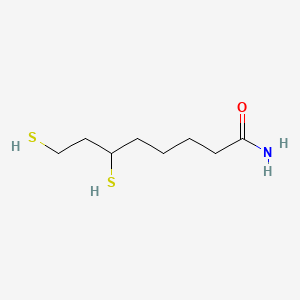| MeSH term | MeSH ID | Detail |
|---|---|---|
| Parkinsonian Disorders | D020734 | 20 associated lipids |
Dihydrolipoamide
Dihydrolipoamide is a lipid of Fatty Acyls (FA) class. Dihydrolipoamide is associated with abnormalities such as Wiskott-Aldrich Syndrome. The involved functions are known as Citric Acid Cycle, Electron Transport, NADH oxidation, Oxidation and Oxidants. Dihydrolipoamide often locates in Mitochondria, Mitochondrial matrix and Chloroplasts. The associated genes with Dihydrolipoamide are Mutant Proteins, Recombinant Proteins, mycothione reductase, Genes, Mitochondrial and alanylproline.
Cross Reference
Introduction
To understand associated biological information of Dihydrolipoamide, we collected biological information of abnormalities, associated pathways, cellular/molecular locations, biological functions, related genes/proteins, lipids and common seen animal/experimental models with organized paragraphs from literatures.
What diseases are associated with Dihydrolipoamide?
Dihydrolipoamide is suspected in and other diseases in descending order of the highest number of associated sentences.
Related references are mostly published in these journals:
| Disease | Cross reference | Weighted score | Related literature |
|---|
Possible diseases from mapped MeSH terms on references
We collected disease MeSH terms mapped to the references associated with Dihydrolipoamide
PubChem Associated disorders and diseases
What pathways are associated with Dihydrolipoamide
There are no associated biomedical information in the current reference collection.
PubChem Biomolecular Interactions and Pathways
Link to PubChem Biomolecular Interactions and PathwaysWhat cellular locations are associated with Dihydrolipoamide?
Visualization in cellular structure
Associated locations are in red color. Not associated locations are in black.
Related references are published most in these journals:
| Location | Cross reference | Weighted score | Related literatures |
|---|
What functions are associated with Dihydrolipoamide?
Related references are published most in these journals:
| Function | Cross reference | Weighted score | Related literatures |
|---|
What lipids are associated with Dihydrolipoamide?
There are no associated biomedical information in the current reference collection.
What genes are associated with Dihydrolipoamide?
Related references are published most in these journals:
| Gene | Cross reference | Weighted score | Related literatures |
|---|
What common seen animal models are associated with Dihydrolipoamide?
There are no associated biomedical information in the current reference collection.
NCBI Entrez Crosslinks
All references with Dihydrolipoamide
Download all related citations| Authors | Title | Published | Journal | PubMed Link |
|---|---|---|---|---|
| Folsom JP et al. | Physiology of Pseudomonas aeruginosa in biofilms as revealed by transcriptome analysis. | 2010 | BMC Microbiol. | pmid:21083928 |
| Xue F et al. | Transcriptional responses of Leptospira interrogans to host innate immunity: significant changes in metabolism, oxygen tolerance, and outer membrane. | 2010 | PLoS Negl Trop Dis | pmid:21049008 |
| Pang S et al. | Regulation of fasting fuel metabolism by toll-like receptor 4. | 2010 | Diabetes | pmid:20855545 |
| Dozot M et al. | Functional characterization of the incomplete phosphotransferase system (PTS) of the intracellular pathogen Brucella melitensis. | 2010 | PLoS ONE | pmid:20844759 |
| He M et al. | Characterization and genomic analysis of chromate resistant and reducing Bacillus cereus strain SJ1. | 2010 | BMC Microbiol. | pmid:20723231 |
| Marselli L et al. | Gene expression profiles of Beta-cell enriched tissue obtained by laser capture microdissection from subjects with type 2 diabetes. | 2010 | PLoS ONE | pmid:20644627 |
| Ma M and Liu LZ | Quantitative transcription dynamic analysis reveals candidate genes and key regulators for ethanol tolerance in Saccharomyces cerevisiae. | 2010 | BMC Microbiol. | pmid:20537179 |
| MacGregor P and Matthews KR | New discoveries in the transmission biology of sleeping sickness parasites: applying the basics. | 2010 | J. Mol. Med. | pmid:20526573 |
| Wei LQ et al. | Genome-scale analysis and comparison of gene expression profiles in developing and germinated pollen in Oryza sativa. | 2010 | BMC Genomics | pmid:20507633 |
| Kim SY and Kim J | Roles of dihydrolipoamide dehydrogenase Lpd1 in Candida albicans filamentation. | 2010 | Fungal Genet. Biol. | pmid:20601046 |
| Shen CJ et al. | Proteomic identification of membrane proteins regulating antimicrobial peptide resistance in Vibrio parahaemolyticus. | 2010 | J. Appl. Microbiol. | pmid:19796120 |
| Sastalla I et al. | Activation of the latent PlcR regulon in Bacillus anthracis. | 2010 | Microbiology (Reading, Engl.) | pmid:20688829 |
| Castro H et al. | Mitochondrial redox metabolism in trypanosomatids is independent of tryparedoxin activity. | 2010 | PLoS ONE | pmid:20838623 |
| Chen W et al. | Disruption of ptLPD1 or ptLPD2, genes that encode isoforms of the plastidial lipoamide dehydrogenase, confers arsenate hypersensitivity in Arabidopsis. | 2010 | Plant Physiol. | pmid:20488895 |
| Pei Y et al. | Plasmodium pyruvate dehydrogenase activity is only essential for the parasite's progression from liver infection to blood infection. | 2010 | Mol. Microbiol. | pmid:20487290 |
| Gutiérrez-Correa J | Trypanosoma cruzi dihydrolipoamide dehydrogenase as target of reactive metabolites generated by cytochrome c/hydrogen peroxide (or linoleic acid hydroperoxide)/phenol systems. | 2010 | Free Radic. Res. | pmid:20815787 |
| Trofimova L et al. | Behavioral impact of the regulation of the brain 2-oxoglutarate dehydrogenase complex by synthetic phosphonate analog of 2-oxoglutarate: implications into the role of the complex in neurodegenerative diseases. | 2010 | Int J Alzheimers Dis | pmid:21049004 |
| Gerards M et al. | Defective complex I assembly due to C20orf7 mutations as a new cause of Leigh syndrome. | 2010 | J. Med. Genet. | pmid:19542079 |
| Peplinski K et al. | Investigations on the microbial catabolism of the organic sulfur compounds TDP and DTDP in Ralstonia eutropha H16 employing DNA microarrays. | 2010 | Appl. Microbiol. Biotechnol. | pmid:20924576 |
| Bruant G et al. | Genomic analysis of carbon monoxide utilization and butanol production by Clostridium carboxidivorans strain P7. | 2010 | PLoS ONE | pmid:20885952 |
